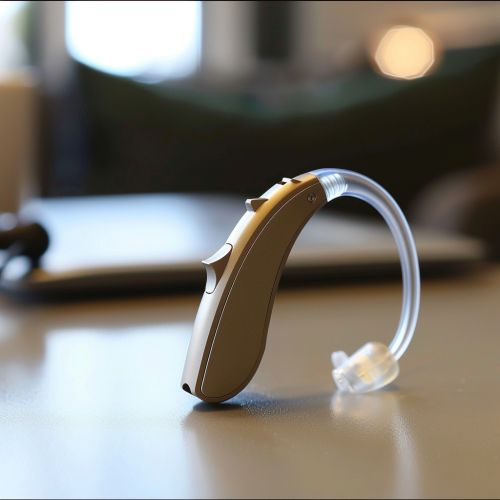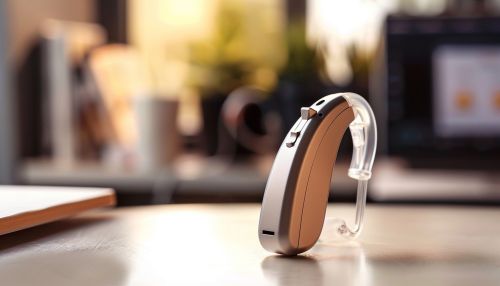Hearing aid: Difference between revisions
(Created page with "== Introduction == A hearing aid is a small electronic device designed to improve hearing by making sound audible to a person with hearing loss. These devices are typically used to help individuals with varying degrees of hearing impairment, from mild to profound. Hearing aids are classified as medical devices in most countries and are regulated by the appropriate health authorities. == History == The development of hearing aids has a rich history, dating back to the 17...") |
No edit summary |
||
| (One intermediate revision by the same user not shown) | |||
| Line 23: | Line 23: | ||
Bone conduction hearing aids bypass the outer and middle ear by transmitting sound vibrations directly to the inner ear through the skull. They are used for individuals with conductive hearing loss or those who cannot wear traditional hearing aids. | Bone conduction hearing aids bypass the outer and middle ear by transmitting sound vibrations directly to the inner ear through the skull. They are used for individuals with conductive hearing loss or those who cannot wear traditional hearing aids. | ||
[[Image:Detail-92899.jpg|thumb|center|A modern hearing aid resting on a table. The device is small, sleek, and has a behind-the-ear design.|class=only_on_mobile]] | |||
[[Image:Detail-92900.jpg|thumb|center|A modern hearing aid resting on a table. The device is small, sleek, and has a behind-the-ear design.|class=only_on_desktop]] | |||
== Components of Hearing Aids == | == Components of Hearing Aids == | ||
Latest revision as of 19:49, 21 June 2024
Introduction
A hearing aid is a small electronic device designed to improve hearing by making sound audible to a person with hearing loss. These devices are typically used to help individuals with varying degrees of hearing impairment, from mild to profound. Hearing aids are classified as medical devices in most countries and are regulated by the appropriate health authorities.
History
The development of hearing aids has a rich history, dating back to the 17th century when ear trumpets were used to amplify sound. The first electronic hearing aids were developed in the early 20th century, utilizing vacuum tube technology. These early devices were large and cumbersome. The invention of the transistor in the 1950s revolutionized hearing aids, making them smaller and more efficient. Modern hearing aids are digital and incorporate advanced technology such as digital signal processing (DSP) and wireless connectivity.
Types of Hearing Aids
Hearing aids come in various styles, each suited to different types of hearing loss and user preferences.
Behind-the-Ear (BTE)
BTE hearing aids consist of a case that sits behind the ear and a tube that connects to an earmold inside the ear canal. They are suitable for all types of hearing loss and are known for their durability and ease of handling.
In-the-Ear (ITE)
ITE hearing aids fit completely inside the outer ear. They are custom-made to fit the user's ear and are suitable for mild to severe hearing loss. ITE devices are less visible than BTE models but may be more susceptible to earwax and moisture damage.
In-the-Canal (ITC) and Completely-in-Canal (CIC)
ITC and CIC hearing aids are smaller than ITE devices and fit partly or completely inside the ear canal. They are less visible and are suitable for mild to moderate hearing loss. However, their small size can make them difficult to handle and adjust.
Receiver-in-Canal (RIC)
RIC hearing aids are similar to BTE devices but have the receiver (speaker) located in the ear canal, connected by a thin wire. This design provides a more natural sound quality and is suitable for mild to severe hearing loss.
Bone Conduction Hearing Aids
Bone conduction hearing aids bypass the outer and middle ear by transmitting sound vibrations directly to the inner ear through the skull. They are used for individuals with conductive hearing loss or those who cannot wear traditional hearing aids.


Components of Hearing Aids
Hearing aids consist of several key components that work together to amplify sound.
Microphone
The microphone picks up sound from the environment and converts it into electrical signals. Modern hearing aids often have multiple microphones to improve directional hearing and reduce background noise.
Amplifier
The amplifier increases the strength of the electrical signals received from the microphone. Digital amplifiers use DSP to enhance sound quality and reduce feedback.
Receiver
The receiver, or speaker, converts the amplified electrical signals back into sound and delivers it to the ear. In RIC and BTE models, the receiver is located in the ear canal or earmold.
Battery
Hearing aids are powered by small batteries, which can be disposable or rechargeable. Battery life varies depending on the device and usage patterns.
Digital Signal Processor (DSP)
The DSP is a microchip that processes sound signals in real-time. It allows for advanced features such as noise reduction, feedback cancellation, and speech enhancement.
Technology and Features
Modern hearing aids incorporate a range of advanced technologies to improve user experience and hearing performance.
Noise Reduction
Noise reduction algorithms help to distinguish between speech and background noise, making it easier for users to understand conversations in noisy environments.
Directional Microphones
Directional microphones focus on sounds coming from a specific direction, usually in front of the user, while reducing sounds from other directions. This feature is particularly useful in noisy settings.
Feedback Cancellation
Feedback cancellation technology reduces or eliminates the whistling sound that can occur when amplified sound is picked up by the microphone and re-amplified.
Wireless Connectivity
Many modern hearing aids offer wireless connectivity, allowing users to stream audio directly from smartphones, televisions, and other devices. Bluetooth technology is commonly used for this purpose.
Telecoil
A telecoil, or T-coil, is a small coil of wire inside the hearing aid that picks up magnetic signals from compatible telephones and assistive listening devices. This feature is particularly useful in public places equipped with hearing loops.
Customization and Programming
Hearing aids can be customized and programmed to suit the specific hearing needs of the user. Audiologists use specialized software to adjust settings such as volume, frequency response, and noise reduction.
Fitting and Adjustment
Proper fitting and adjustment are crucial for the effectiveness of hearing aids. The process typically involves several steps:
Hearing Assessment
An audiologist conducts a comprehensive hearing assessment to determine the type and degree of hearing loss. This assessment includes pure-tone audiometry, speech audiometry, and other diagnostic tests.
Selection
Based on the hearing assessment, the audiologist recommends the most suitable type and model of hearing aid. Factors considered include the user's hearing loss, lifestyle, and preferences.
Ear Impressions
For custom-fit hearing aids, the audiologist takes impressions of the user's ear canals. These impressions are used to create earmolds or custom shells for the hearing aids.
Programming
The hearing aids are programmed using specialized software to match the user's hearing profile. This process involves adjusting various parameters to optimize sound quality and comfort.
Verification and Validation
Verification involves measuring the hearing aid's performance using real-ear measurements or test box measurements. Validation assesses the user's satisfaction and benefit from the hearing aids through questionnaires and subjective feedback.
Follow-up and Maintenance
Regular follow-up appointments are essential to ensure the hearing aids continue to meet the user's needs. Maintenance includes cleaning, battery replacement, and occasional reprogramming.
Impact on Quality of Life
Hearing aids can significantly improve the quality of life for individuals with hearing loss. Benefits include improved communication, increased social participation, and enhanced overall well-being. However, the degree of benefit varies among users and depends on factors such as the severity of hearing loss, the quality of the hearing aids, and the user's commitment to consistent use.
Challenges and Limitations
Despite their benefits, hearing aids have certain limitations and challenges:
Adaptation Period
Users often require an adaptation period to get used to the amplified sounds and the physical presence of the hearing aids. This period can vary from a few days to several months.
Background Noise
While modern hearing aids have advanced noise reduction features, distinguishing speech in noisy environments can still be challenging.
Maintenance
Hearing aids require regular maintenance, including cleaning and battery replacement. Moisture, earwax, and physical damage can affect their performance.
Cost
Hearing aids can be expensive, and not all insurance plans cover the cost. Financial barriers can limit access to these essential devices.
Future Developments
The field of hearing aid technology is continuously evolving, with ongoing research and development aimed at improving performance and user experience. Some promising areas of development include:
Artificial Intelligence (AI)
AI algorithms can enhance sound processing, providing more accurate noise reduction, feedback cancellation, and speech enhancement. AI can also enable hearing aids to learn and adapt to the user's listening preferences over time.
Health Monitoring
Future hearing aids may incorporate health monitoring features, such as tracking physical activity, heart rate, and detecting falls. These features can provide valuable health data and enhance the overall functionality of the devices.
Enhanced Connectivity
Advancements in wireless technology will improve connectivity with a wider range of devices, including smart home systems and personal assistants. This integration can provide a more seamless and convenient user experience.
Regenerative Medicine
Research in regenerative medicine and gene therapy holds the potential to restore natural hearing by repairing or regenerating damaged hair cells in the inner ear. While still in the experimental stage, these approaches could eventually reduce the need for hearing aids.
